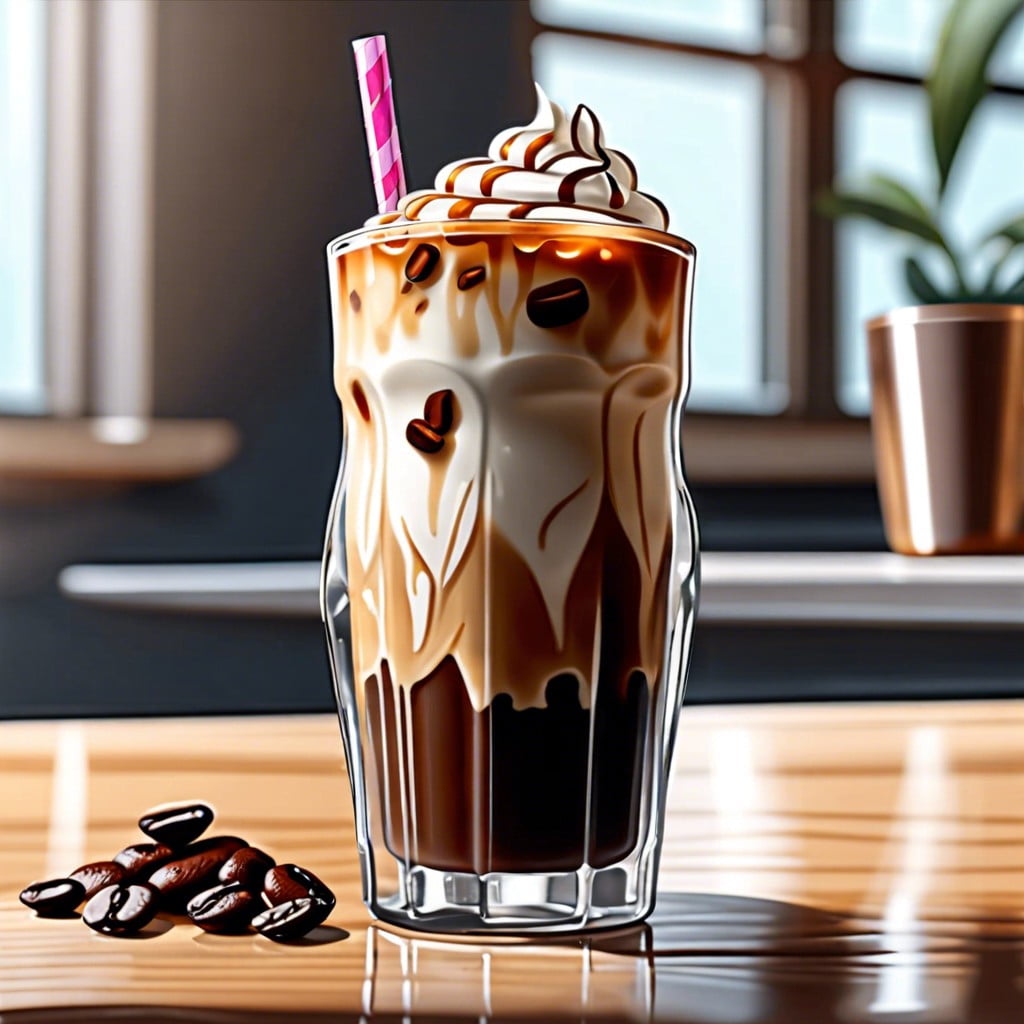Discover the differences between cold brew and iced coffee to determine which chilled beverage will best satisfy your coffee cravings.
What’s Iced Coffee?

Iced coffee is simply regular coffee that’s cooled down and served over ice. It starts its life as a hot brew, which can be made using any method—drip, pour-over, or even espresso. Typically, the brewed coffee is made stronger than usual to counteract the dilution caused by the ice.
This caffeinated beverage offers a refreshing twist on your classic cup of joe, ideal for sipping on hot days. While the process is swift and straightforward, the taste can vary wildly from bold and invigorating to mellow and sweet, thanks to the different brewing methods and the possibility for milk, sugar, or flavor add-ins.
Iced coffee is a quick, punchy pick-me-up; it’s coffee’s answer to a crisp morning that turns into a warm afternoon.
Cold Brew Coffee: What It Is?
Imagine a coffee that’s been steeped like a fine tea, undergoing a gentle extraction process over 12 to 24 hours. That’s what gives cold brew its character. Unlike a quick-steeped tea, cold brew coffee soaks at room temperature or in the refrigerator, with coarse grounds swirling in cold water for an extended period. This slow dance between water and coffee grounds creates a concentrate, typically diluted with water or milk before serving.
Its lower acidity gives cold brew a smoother, naturally sweeter flavor, often making it a friendlier option for those with sensitive stomachs. The extended brewing time leads to a less bitter cup, highlighting the chocolatey and fruity notes of your favorite bean. This chilled brew, once a niche favorite, has claimed its rightful place in the sun as a summer staple with a velvety finish that’s hard to resist.
Cold Brew Vs Iced Coffee: Key Differences
Dive into the brewing process and you’ll find that iced coffee is simply hot coffee that’s been cooled down and served over ice. By contrast, cold brew is made with cold water from start to finish, steeping for anywhere from 12 to 24 hours.
Next, let’s talk flavor. Iced coffee often has the same boldness as its hot counterpart, with a hint of refreshing coolness. Cold brew, on the other hand, is the smooth operator: mellow, with a natural sweetness and lower acidity that many find easier on the palate and the stomach.
Caffeine content is another battleground. Since cold brew often uses a higher coffee-to-water ratio, it packs a stronger punch compared to the average iced coffee. Always consider your own caffeine sensitivity before choosing your champion.
Lastly, there’s the question of shelf life. Iced coffee is the ephemeral art of the coffee world, best enjoyed shortly after brewing. Cold brew, with its concentrated essence, can give you that java jolt for days when stored properly in the fridge. It’s the tortoise to iced coffee’s hare: slow and steady wins the race.
In sum, your choice might boil down to how quickly you want your coffee, the taste you prefer, and the jolt you need. Every sip tells a story, so what’s yours going to be?
Brewing Process
Grasping the quirks between cold brew and iced coffee starts with their individual brewing rituals. Iced coffee is a bit like a sprinter – quick and energetic. Hot water pours over coffee grounds, extracting flavors and caffeine briskly, then plummets to a chill with a deluge of ice. Chop-chop, and you have a refreshing but possibly diluted concoction.
Flip the script, and you find cold brew – more a marathon runner. Grounds steep in cool water for a sprawling period, ranging from 12 to 24 hours. This gentle, slow dance teases out a smooth, sweet flavor while leaving behind much of the bitter bite. No rush here, patience is a virtue, and the result: a concentrate that’s strong, resilient, and versatile, much like a trusty tortoise, slow but unstoppable.
Flavor & Acidity
Let’s spill the beans on taste—cold brew is the smooth criminal of coffees, sliding across your palate with low acidity and balanced sweetness. Due to its lengthy steeping time at cooler temperatures, the bitter compounds don’t crash the party, leaving behind a mellow flavor that’s friendlier to sensitive stomachs.
On the flip side, iced coffee is essentially hot coffee that’s been cooled down, carrying a more pronounced acidity. Think of it as a zesty cousin that brings a sharper, brighter flavor to your taste buds. Those who prefer a tangy kick and toasty notes often stick by iced coffee.
Time affects taste, too. Cold brew stays in its flavor groove for days, keeping its cool in your fridge. Iced coffee? Best enjoyed fresh, as its taste can get as stale as yesterday’s bagels if it’s left too long.
Sugar and milk step differently in these two dances. Cold brew can sip solo without bitterness, while iced coffee often pairs with sweeteners or dairy to soften its edges. Each has loyal fans in the flavor face-off, really, it boils down to what jives with your palate.